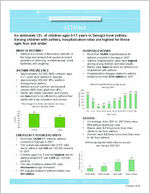The Georgia Department Of Community Health
2010 Georgia Data Summary
ASTHMA
An estimated 12% of children ages 0-17 years in Georgia have asthma. Among children with asthma, hospitalization rates are highest for those ages four and under.
WHAT IS ASTHMA? Asthma is a chronic inflammatory disorder of
the lungs and airways that causes recurrent episodes of wheezing, breathlessness, chest tightness, and coughing
ASTHMA PREVALENCE Approximately 297,000 (12%) children ages
0-17 years have asthma in Georgia Approximately 600,000 (9%) adults in
Georgia have asthma Asthma is more common among adult
women (11%) than adult men (6%) Adults with higher education and income
are less likely to be affected by asthma than adults with lower education and income
Percentage of children and adults who have asthma, Georgia, 2008
14%
12%
12%
10%
8%
6%
4%
2%
0%
Children
9% Adults
EMERGENCY ROOM (ER) VISITS More than 54,000 ER visits for asthma
occurred in Georgia in 2007 The overall age-adjusted rate of ER visits
due to asthma was 560 per 100,000 persons in 2007 Children ages 0 to 4 had the highest rate for asthma-related ER visit 1,428 per 100,000 persons The rate of asthma-related ER visits decreased as age increased ER charges related to asthma totaled over $63 million
Rate per 100,000
RatReatperp1e0r0,100,0000
HOSPITALIZATIONS More than 10,000 hospitalizations for
asthma occurred in Georgia in 2007 Asthma hospitalization rates were highest
among young children and older adults Blacks were twice as likely as whites to be
hospitalized with asthma Hospitalization charges related to asthma
totaled more than $132 million in 2007
Asthma hospitalizations by age group,
Asthma hospGiteaolirzgaitaio, 2n0s0b7y age group,
Georgia, 2007
300
235000 228 220500 228
239 240 212 239 240 212
125000 1050 15000
500
120
125 140
120
79 125 140
34 49 79
34 49
0 0-4 5-14 15-24 25-34 35-44 45-54 55-64 65-74 75-84 85+
0-4 5-14 15-24 25-34 3A5g-4e4G4ro5-u5p4 55-64 65-74 75-84 85+
DEATHS
Age Group
On average, from 2001 to 2007 there were
113 asthma deaths per year
Blacks were 2.7 times more likely than
whites to die from asthma
Women were 1.5 times more likely than men
to die from asthma
AsDthemaathargaet-easdjfursotmedadsethatmharaitnecsr,ebaysreadcewaitnhdage
sex, Georgia, 2001-2007
5
4
2.9
3
2.3
2
1.2
1
0.7
0 White Males White Females Black Males Black Females
Percent
2 Peachtree Street, Atlanta, Ga 30303 w www.dch.georgia.gov
October 2010
2010 Georgia Data summary | Asthma
CHILDREN: Asthma Management and Training Thirty eight percent (38%) of children with asthma
in Georgia had an asthma attack in the past year Fourteen percent (14%) of children with asthma
had to visit an emergency room or urgent care center because of their asthma in the past year Thirty six percent (36%) of children with asthma were allowed to have asthma medicine at school. (Georgia code OCGA 20-2-774 (2004). A statute authorizing students to self administer asthma medication, pursuant to local adopted school policies.) Fifty eight percent (58%) of children with asthma have never been given an asthma action plan by a doctor or other health professional Seventy nine percent (79%) of children with asthma were taught by a doctor or health professional to recognize early signs of an asthma episode Seventy six percent (76%) of children with asthma were taught by a doctor or health professional what to do during an asthma attack
ADULTS: Asthma Management Thirty eight percent (38%) of adults with asthma
reported having an episode of asthma or an asthma attack in the past year Eleven percent (11%) of adults with asthma reported having to visit an emergency room or urgent care center because of their asthma in the past year Forty five percent (45%) of adults with asthma reported being unable to work or carry out usual activities on one or more days in the past year Twenty nine percent (29%) of adults with asthma reported having no routine checkups for their asthma in the past year Seventy two percent (72%) of adults with asthma reported never being given an asthma action plan by a doctor or other health professional Fifty seven percent (57%) of adults with asthma reported never being taught by a doctor or health professional to recognize early signs of an asthma attack Sixty three percent (63%) of adults with asthma reported being taught by a doctor or health professional what to do during an asthma attack
Date updated: December 2009 Visit http://www.health.state.ga.us/epi/cdiee/asthma.asp for more information about asthma in Georgia.
ASTHMA PREVENTION AND MANAGEMENT
Know the common triggers
Exposure to the following environmental irritants and allergens can cause an asthma attack.
Tobacco smoke Dust mites Pets (animal dander) Cockroaches Fungi and molds (indoor and outdoor)
Take control of asthma
Reduce exposure to your triggers Work with your doctor to create an asthma
management plan Monitor your breathing and airways with a
peak flow meter, as recommended by your doctor Treat symptoms early Learn when to seek medical help
Create an asthma management plan
An asthma management plan is a written guide set up by your doctor and you to help manage your asthma, based on your individual needs. Your plan will tell you:
What brings on your asthma symptoms How to avoid triggers and reduce exposure What medicines to take and when to take
them When you need to seek medical help
Tips for using an asthma management plan
Go over each step of the plan with your doctor
Understand instructions for medications Learn to use equipment, such as nebulizers,
properly Schedule routine visits to discuss your
asthma with your doctor Let your doctor know if your plan is not
working, so that the plan can be revised as needed
Data sources 1. 2008 Georgia Behavioral Risk Factor Surveillance
System (BRFSS) (http://health.state.ga.us/epi/brfss/ publications.asp) 2. 2007 Georgia Vital Statistics 3. 2007 Georgia Emergency Department and Hospital Inpatient Discharge Data 4. 2008 Georgia Child Asthma Callback Survey 5. 2008 Georgia Adult Asthma Callback Survey
